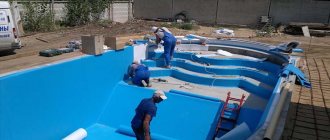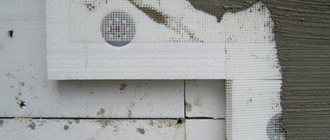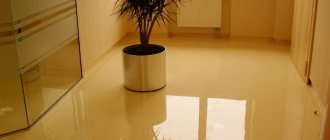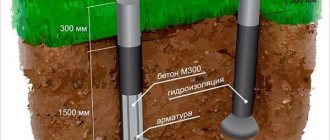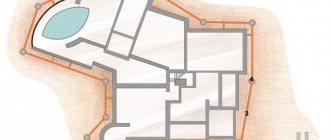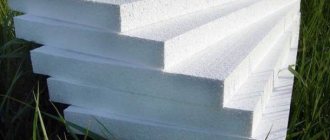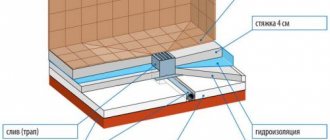Concrete has been the most popular building material for many years. Despite the very long history of its origin, concrete has become widespread and recognized only in the last century. Moreover, the volume of concrete produced and used in construction is growing year by year. This demand is quite understandable: concrete is a universal material with high strength and a wide range of uses.
But there is a characteristic of this material that I would like to improve or at least compensate for. Despite all its hardness, the water-repellent properties of this material are poor. If you look closely, even with the naked eye you can see the smallest pores on the surface. Moisture can penetrate deep into the material through these pores. With prolonged exposure to dampness and temperature changes, concrete products and structures can collapse.
To solve the problem of structural deformations and temperature microfractures of concrete, mandatory actions are needed to waterproof the concrete surface. This is especially necessary if the concrete is used in conditions of high humidity or in contact with water: foundations, garage floors, swimming pools, etc.
Waterproofing concrete
Waterproofing materials and methods of their use
There are many materials and methods for waterproofing concrete. The choice of a suitable solution will depend on the location of application, the processing area, the intensity of use, and the possible budget.
Concrete waterproofing options:
- penetrating waterproofing for concrete;
- concrete additives for waterproofing;
- liquid waterproofing for concrete;
- coating waterproofing for concrete;
- glued or built-on waterproofing;
- sealant for concrete.
Penetrating waterproofing
Why is it needed?
When concreting the foundation and plinth, it is important to protect the base from moisture, otherwise after 2-3 years the structure will lose its strength characteristics and begin to collapse. To prevent this from happening, waterproofing work is carried out during the construction of the structure and pouring the foundation. The technology for carrying out protection is simple; it is important that the weather is sunny and dry. If you want to save money, you can waterproof concrete yourself. But it is better to hire a team of builders, since various moisture-proofing additives have been developed, and it is important to choose the right one for a particular case.
Penetrating concrete waterproofing
Cement-based waterproofing, although it was known 50 years ago, was not widely used then.
The principle of operation of penetrating waterproofing is that the chemical elements included in its composition, after hitting the surface of the wall, penetrate under the influence of physical forces into microcapillaries in the thickness of the concrete. The name of this method of waterproofing comes from the ability to penetrate the wall.
In capillaries, the active ingredients of the mixture interact with the substances that make up the concrete. Next, a kind of micro-plugs are formed that completely block the movement of liquid from the inside, but do not reduce the vapor permeability of the wall.
For a long time, synonymous with penetrating concrete waterproofing was the dry cement-based waterproofing mixture Penetron. This is due to the fact that Penetorone was the only such remedy for a long time. But today the construction market offers waterproofing mixtures from many other manufacturers.
The penetrating mixture for waterproofing is available in dry form. After mixing with water, apply to concrete using a wide brush with synthetic bristles. The solution should be mixed immediately before work and in an amount that can be used within 30 minutes.
Cement based waterproofing
Foundation protection with polyurea
Polyurea is a multicomponent organic polymer. Components: isocyanate, polyester amine resin.
To apply polyurea, you will need special equipment that provides heating before spraying the components to a temperature of >+80 degrees, separate supply to the mixing chamber of the gun and to the treatment site under a pressure of >1.7 atm.
Polyurea is applied for horizontal and vertical waterproofing.
After connecting the components and contacting the surface to be treated, the mixture hardens within 10 seconds. A durable layer is formed, similar to hard rubber or plastic.
Characteristics of the resulting polyurea layer:
- thickness: 0.5—2.5 mm;
- Full readiness for use 1 minute after application;
- no seams;
- operating mode from -60 to +250 degrees;
- strength up to 80 Shore D;
- corrosion and abrasion resistant coating;
- service life >30 years.
Additives to concrete for waterproofing
To improve the inherent characteristics of concrete, various additives are added to its composition at the stage of mortar production. Additives make concrete waterproofing or hydrophobic.
Hydrophobic concrete
This concrete, after hardening, acquires the property of repelling water from its surface. The following types of additives are used:
- paraffins;
- calcium salts;
- stearic acid;
- salts of naphthenic acids;
- petroleum acids;
- resin
An additive to concrete for its hydrophobicity can be hydrophobic (an immiscible admixture with certain characteristics) and hydrophobic (giving a water-repellent effect when interacting with concrete substances).
Waterproofed concrete
By using waterproofing additives in concrete, it is possible to obtain a material with less air content. Waterproofing additives in concrete compact the mixture and increase the concrete’s own resistance to moisture.
Waterproofing additives include:
- ferric chloride;
- calcium nitrate;
- silicate glue.
Additives to concrete for waterproofing
Waterproofing impregnation for concrete
There are two types of liquid impregnation for concrete waterproofing:
- Deep penetration (silicate-based mixtures). This impregnation significantly increases the strength of concrete, which determines the waterproofing effect.
- Waterproofing of surface protection (on the frame of epoxy, acrylates, polyurethanes). Such impregnations create a film on the surface and prevent liquid from seeping into the concrete, but do not affect its strength.
Might be interesting
Waterproofing
How to choose the right floor waterproofing for screed?
Waterproofing
Foundation waterproofing: optimal choice of technology
Waterproofing
Clean water is the key to health, waterproofing concrete…
Waterproofing
Instructions for waterproofing a swimming pool
This type of waterproofing is one of the easiest to apply. It is enough to apply the liquid waterproofing composition to a vertical concrete surface with a roller or brush. Horizontal surfaces, such as floors or ceilings, are most convenient to waterproof. It is enough to pour the impregnation into a thin layer, spread evenly with a soft brush and let dry.
Waterproofing impregnation
Mastic for concrete waterproofing
Mastic waterproofing is very popular for various reasons. This is a fairly affordable way to protect concrete from the harmful effects of moisture. The mastic is easy to apply and has sufficient fluidity to create a uniform coating during the drying process. In this case, the coating is smooth, without seams or joints.
Mastic can be used both in air and in contact with soil, protecting concrete equally well from atmospheric precipitation and from groundwater and melt water.
There are two main types of mastics for waterproofing:
- Bitumen mastic. One of the cheapest and oldest waterproofing for concrete. The main component of this coating is bitumen. Bituminous mastic is applied when heated. Polymer additives are added to the material to improve the fluidity, polymerization and elasticity of the cooled coating. In addition, additives allow you to apply bitumen mastic in a cold way.
- Polyurethane mastic. Made from acrylic. When dry, it completely polymerizes, creating a dense protective coating on concrete. The advantages of polyurethane mastic are drying speed and resistance to ultraviolet radiation. Hydrophobic acrylic mastic is also good because you can add dye to it and tint the coating to the desired color. Also, acrylic-based mastic is lighter than bitumen.
Mastic coating is convenient to use for waterproofing surfaces with complex terrain, as it is applied using a sprayer, or less often with a brush or roller. At the same time, you can be sure that both external and internal corners will be well processed.
For best results, the mastic layer can be up to several centimeters thick. The minimum permissible thickness is 1 mm.
Mastic for waterproofing
Why not do without waterproofing?
For the foundation of a house, any moisture becomes a source of problems, because its elimination is a labor-intensive process that requires additional considerable expenses. Therefore, it is wiser to take care of protecting the foundation during the construction phase.
Foundation waterproofing cannot be neglected because:
When laying a building, the concrete solution leaks into the soil, which significantly weakens the structure in the future.- The foundation of the house is in constant contact with a humid environment, this includes:
- groundwater;
- melt moisture;
- precipitation (snow, rain);
- flooding as a result of seasonal river flooding.
- Unprotected concrete absorbs moisture through capillaries, which crystallizes and expands the foundation, forming cracks.
- It’s not pleasant when there is water in the basement, and the basement cannot be fully used.
- A damp basement in a home becomes a source of mold spreading up the walls.
- The building is being built for more than one decade.
Adhesive and weld-on coatings for waterproofing concrete surfaces
Waterproofing concrete using roll coatings is one of the most traditional. Materials are manufactured based on bitumen. Old generation coatings had a significant drawback - they were very fragile, which created difficulties both during installation and during further operation. Now polymers are added to the bitumen used for the manufacture of roll waterproofing, which significantly improves the characteristics of the material.
Roll waterproofing based on bitumen is divided according to the installation principle into:
- Pasting. To install waterproofing, the surface is first coated with bitumen mastic. Next, lay the waterproofing itself and carefully level it. The joints are overlapped and glued together with mastic. Waterproofing can be done in several layers, alternating mastic and rolled material.
- Welded. This waterproofing is bonded to the coating using burners. The material is rolled out over the surface and heated. The mastic layer melts and glues the canvas to the base. The joints are also overlapped.
Welded waterproofing
Conclusion
By choosing the optimal type of waterproofing at the construction stage and installing it correctly, you can really avoid problems in the future. If the need arises, to protect structures there are a lot of modern waterproofing materials characterized by a high degree of reliability.
On the topic, you can familiarize yourself with the experience of portal participants in finishing wet rooms in wooden houses. And if you want something unusual, try moisture-resistant plaster Tadelakt. The video shows an unusual sink for a wooden house.
Subscribe to our Telegram channelExclusive posts every week
Sealant for concrete
Sealant is used when it is necessary to waterproof small cracks or seams in concrete. There are a large number of different sealants that differ in the main ingredient: rubber, bitumen, silicate, silicone, acrylic, polyurethane, etc.
Three of them are the most popular:
- Acrylic sealant. Made from acrylic. By and large, it's more of a putty. It does not waterproof very well, but it can fill large spaces, levels well and is beautifully painted after drying;
- Polyurethane sealant. It quickly bonds to the surface and, after polymerization and drying, has high strength. It has proven itself to be excellent for sealing seams and joints between slabs. Paint can be applied over the dried polyurethane sealant;
- Silicone sealant. The most commonly used and popular. Best protects against moisture and dampness. Can be used on different surfaces as it has high adhesion. The downside is its insusceptibility to painting - paint simply does not adhere to dried silicone sealant. But there are already tinted silicone sealants.
Silicone sealants can be acidic or neutral. For work on concrete, exclusively neutral silicone sealants are used, since acids, when reacting with substances from concrete, can destroy both the concrete itself and the sealant.
Sealant for concrete
Waterproofing concrete with “liquid glass”
Liquid glass is a substance that is a mixture of sodium and potassium silicates. The composition of liquid glass is similar to stationery glue. The silicates that make up liquid glass react with concrete components and plug microcracks in layers close to the surface.
Liquid glass is a penetrating waterproofing material. Application is very simple - using a brush or roller. You can do the work yourself. But, it should be noted that the composition is fragile after drying, so such waterproofing requires protection from mechanical damage.
Waterproofing concrete with “liquid glass”
In principle, when using high quality cement mortar and high inherent strength, as well as creating certain molding and drying conditions, it is possible to obtain practically waterproof concrete. This type of concrete is used in the construction of high-rise buildings and special-purpose structures. Under normal conditions, making such concrete is very difficult. Especially when it comes to low-rise private construction.
To increase the service life of buildings and to reduce the impact of moisture on them, waterproofing of concrete is necessary. A variety of materials can be used for this: concrete sealant; hydrophobic additives for concrete; mastic for concrete; welded or glued rolls. The main thing is that the waterproofing is selected appropriately, and the treatment is done professionally.
